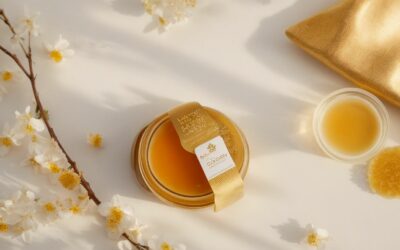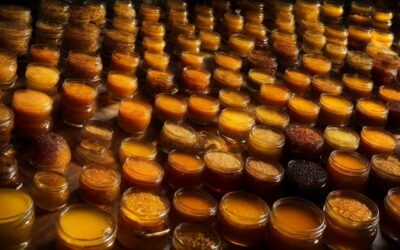Welcome, honey lovers! Are you confused about the different ratings and labels for Manuka honey? Do you want to make sure you’re getting the best quality?
Look no further, as this guide will break down the complex world of Manuka honey ratings and help you find the perfect jar for you.
How Are Manuka Honey Ratings Determined?
When browsing for manuka honey, you may have noticed different rating systems such as MGO, UMF, and KFactor. But how exactly are these ratings determined?
In this section, we will delve into the factors that contribute to each type of rating, providing a comprehensive guide to understanding manuka honey ratings.
From the unique properties of the honey to the testing and certification processes, we will uncover the key elements that influence the final rating.
Let’s dive into the world of manuka honey ratings and unravel the mystery behind their numbers.
1. MGO Rating Factors
The MGO rating is a crucial aspect to consider when assessing the quality of Manuka honey. Here are the main factors to keep in mind:
- Manuka plant source: The MGO rating of the honey is influenced by the specific species of the Manuka plant it is derived from.
- Purity: The honey must come from areas free of contamination and pollutants.
- Processing: The honey should undergo minimal processing to preserve its natural properties.
- Storage: Proper storage conditions, such as keeping the honey away from direct sunlight and extreme temperatures, can impact its MGO rating.
- Testing: Reputable producers conduct thorough testing to ensure accurate MGO ratings.
2. UMF Rating Factors
UMF (Unique Manuka Factor) rating factors play a crucial role in determining the quality and authenticity of Manuka honey.
These factors take into account the presence of key chemical markers, including DHA (Dihydroxyacetone), Methylglyoxal (MGO), and Leptosperin.
The UMF rating also considers the non-peroxide activity, which is unique to Manuka honey. A higher UMF rating indicates a higher concentration of these markers, indicating better quality and medicinal properties.
Other factors that contribute to the UMF rating include sustainable beekeeping practices, proper processing, and packaging.
When choosing Manuka honey, it is recommended to look for a UMF rating of 10+ for general wellness and 15+ for therapeutic benefits.
A pro-tip is to always check for the UMF trademark and certification on the label to ensure authenticity.
3. KFactor Rating Factors
The KFactor rating of Manuka Honey is determined based on several factors that indicate its authenticity and quality. Here are the key factors considered in the KFactor rating:
- Manuka Pollen Count: The higher the pollen count from the Manuka flower, the higher the KFactor rating.
- Presence of Other Pollens: The absence of pollens from other plant species ensures the purity of Manuka Honey, boosting its KFactor rating.
- Chemical and Antibiotic Residue: The KFactor rating takes into account the absence of chemical residues or antibiotics in the honey.
- Key Markers: Certain chemical markers, such as leptosperin and methylglyoxal, are measured to determine the KFactor rating.
Pro-tip: When choosing Manuka Honey, look for a higher KFactor rating to ensure top-quality and maximum health benefits.
What Do the Ratings Mean?
When it comes to purchasing Manuka honey, you may have noticed various ratings on the labels such as MGO, UMF, or KFactor. But what do these ratings really mean?
In this section, we will dive into the different rating scales used for Manuka honey and how they can affect the quality and potency of the honey.
From the MGO rating scale to the UMF and KFactor scales, we will break down the meanings and significance of each one. So let’s get to the bottom of what these ratings really mean.
1. MGO Rating Scale
The MGO rating scale is utilized to measure the strength of Manuka honey. It evaluates the quantity of Methylglyoxal, a compound responsible for its unique properties.
The scale ranges from 30 to 1000+, with higher values indicating higher levels of MGO. A rating of 30-100 is considered low, while 400+ is classified as high.
The MGO rating is crucial in determining the honey’s antibacterial activity and therapeutic benefits. When selecting Manuka honey, it is important to consider your specific needs and desired effects.
Higher MGO ratings are generally recommended for medicinal purposes, while lower ratings are suitable for everyday use and maintaining overall well-being.
2. UMF Rating Scale
The UMF rating scale is an important tool used to determine the quality and potency of Manuka honey. To better understand this scale, follow these steps:
- Look for the UMF trademark on the packaging of Manuka honey.
- Check the number next to the UMF symbol, which can range from 5 to 20+.
- A higher UMF rating indicates higher levels of unique compounds found in Manuka honey.
- Consider your specific needs and preferences when selecting a UMF rating.
Fun Fact: Manuka honey with a UMF rating of 10 or higher is believed to have therapeutic benefits.
3. KFactor Rating Scale
The KFactor rating scale is a useful tool for assessing the quality of Manuka honey based on its pollen count and purity. To better understand this rating scale, follow these steps:
- Check the Manuka honey packaging for the KFactor rating.
- A higher KFactor rating indicates a higher pollen content and better quality honey.
- A KFactor rating of 16 or above guarantees genuine Manuka honey.
- Look for the KFactor guarantee logo to ensure the authenticity of the honey.
- Consider your specific needs and desired benefits when selecting a KFactor rating.
By following these steps, you can confidently use the KFactor rating scale to find the best quality Manuka honey for your needs.
Which Rating Should I Choose?
When selecting Manuka honey, it’s important to consider the rating which indicates its potency and quality. The rating system is based on the honey’s unique property called MGO (Methylglyoxal) content.
The higher the MGO level, the stronger the antibacterial properties.
So, Which Rating Should You Choose? It depends on your specific needs and preferences. If you’re looking for a mild taste and general health benefits, a lower MGO rating like 100+ will suffice.
However, if you’re seeking potent antibacterial properties, higher ratings like 400+ or 800+ are recommended.
How to Use Manuka Honey Ratings to Find the Best Quality Honey?
To find the best quality Manuka honey, follow these steps:
- Understand the rating system: Look for a Unique Manuka Factor (UMF) rating on the label, which indicates the potency and quality of the honey.
- Check for authenticity: Verify that the honey is from New Zealand and has a license number from the UMF Honey Association.
- Consider the UMF level: Higher UMF levels indicate stronger antibacterial properties and greater therapeutic benefits.
- Assess the MGO content: Methylglyoxal (MGO) is a key component of Manuka honey’s antibacterial properties. Look for a higher MGO content for more potent honey.
- Read customer reviews: Pay attention to feedback from other consumers to gauge the honey’s taste, texture, and effectiveness.
A friend of mine was suffering from a persistent sore throat. After learning how to use Manuka honey ratings to find the best quality honey, she purchased a jar with a high UMF rating.
Within days of using it, her symptoms improved, and she was able to naturally soothe her throat. This experience convinced her of the effectiveness of using Manuka honey ratings to find the best quality honey for her health needs.
Frequently Asked Questions
What are manuka honey ratings?
Manuka honey ratings are a system used to measure the potency and quality of manuka honey. They are based on the unique properties and chemical markers found in manuka honey, which are used to determine its strength and purity.
How are manuka honey ratings determined?
Manuka honey ratings are determined through a grading system based on the concentration of methylglyoxal (MGO) in the honey. The higher the MGO level, the stronger and more potent the manuka honey is.
What is MGO and why is it important in manuka honey ratings?
MGO stands for methylglyoxal, which is a compound found in high amounts in authentic manuka honey. It is responsible for the unique antibacterial and healing properties of manuka honey, making it a key factor in determining its potency and quality.
What are the different manuka honey ratings and what do they mean?
There are three main manuka honey ratings: UMF, MGO, and KFactor. UMF (Unique Manuka Factor) and MGO (Methylglyoxal) ratings measure the levels of these specific compounds, while KFactor is a rating system developed by a company to measure the honey’s purity and quality.
What is the difference between UMF and MGO ratings?
UMF and MGO ratings are both used to measure the potency of manuka honey, but they use different methods. UMF is a measure of the honey’s antibacterial activity, while MGO is a measure of the concentration of methylglyoxal in the honey. Both are valid ratings and can be used to determine the strength of manuka honey.
How can I use manuka honey ratings to choose the right honey for me?
The best way to use manuka honey ratings is to consider your specific needs. If you are looking for a honey with high antibacterial properties, choose one with a high UMF or MGO rating. If you are looking for a pure and high-quality honey, a high KFactor rating would be ideal.
I’m a Manuka honey enthusiast and creator of Manuka Honey Organic, a blog where I share my journey with authentic Manuka honey from New Zealand. I want everyone to learn about the healing powers of Manuka honey.





